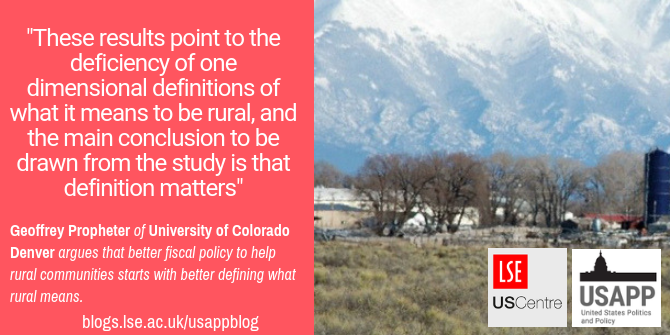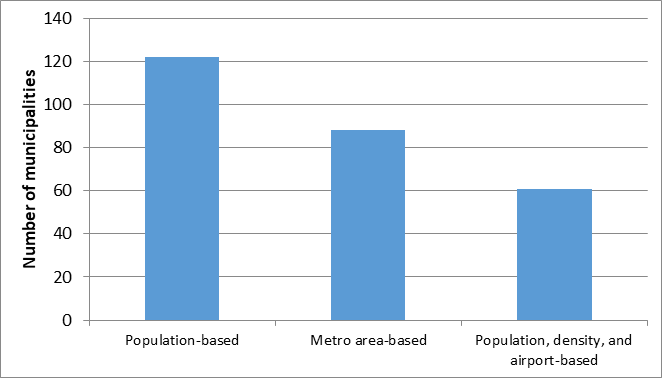 What makes a community ‘rural’? Is it its population, or its location compared to urban areas? With the federal government allocating millions to support rural development, these definitions matter. In new research, Geoffrey Propheter tests a new definition of ‘rurality’ which incorporates population, population density, and airport proximity. He finds that depending on which definition is used, the likelihood of a community adopting certain fiscal policies – such as a local option sales tax – can vary considerably.
What makes a community ‘rural’? Is it its population, or its location compared to urban areas? With the federal government allocating millions to support rural development, these definitions matter. In new research, Geoffrey Propheter tests a new definition of ‘rurality’ which incorporates population, population density, and airport proximity. He finds that depending on which definition is used, the likelihood of a community adopting certain fiscal policies – such as a local option sales tax – can vary considerably.
Governments in the US invest heavily in rural areas. The federal government provides loans and grants to help rural local governments invest in broadband, housing, and economic development through USDA and HUD, for instance, while nearly every state has a rural economic development program.
Despite differences in program benefits and targeted public services, the overwhelming majority of these programs define what counts as rural on the basis of population. Conversely, most academic research, and few public programs, tend to define rurality in terms of a community’s location outside of metro areas, as defined by the US Office of Management and Budget.
Both of these unidimensional definitions are problematic. Defining program eligibility strictly in terms of population ignores the intuitive spatial component of rurality, which suggests that population-based definitions result in misallocation of public funds; monies that are intended to go towards truly rural communities may end up in the coffers of small towns that are economically better off given their closer proximity to urban centers. Under Colorado’s Rural Economic Initiative, for instance, the $209,000 in grants awarded to four small communities in 2016, all of which are located near to urban centers, would have been allocated elsewhere had the state used a more sophisticated definition.
Moreover, a metro area-based definition results in some inconsistent categorization. Again borrowing from Colorado, the town of Ramah, for instance, has a population of about 130, a population density per square mile of about 520, and lies within the Colorado Springs metro area. Approximately the same road-mile distance away from Ramah to downtown Colorado Springs but in the opposite direction is the town of Hugo in Lincoln County, which is outside of any metro area. Hugo had an estimated population of 730 and a density of 780 per square mile. In other words, Ramah looked more like Hugo than Colorado Springs (population: 445,830; population density: 2,288 per square mile) or its immediate suburban areas, and yet the metro area definition catalogs Ramah as urban and Hugo as rural.
To more properly target public aid for rural communities, and for academic research to more properly evaluate program effectiveness, we must avoid using simplistic definitions of rurality.

“Rural Colorado” by SLV Native is licensed under CC BY NC SA 2.0
In a recent study of municipal governments in Colorado I proposed a definition of rurality which includes more dimensions, which I then used to demonstrate that what we know about rural governments is sensitive to how we choose to define them.
I defined a rural municipality as any incorporated community having fewer than 10,000 residents, fewer than 1,000 residents per square mile, and is farther than 41 miles away from a large commercial passenger airport. I used airport distance as an indicator given the considerable research indicating airports are strong predictors of economic development, a condition for urbanization. Any community meeting only the first two definitions I categorized as a small town whereas a rural town is small but also exceeds the airport distance threshold.
Since this multi-dimensional definition is more restrictive, it is unsurprising that fewer municipalities qualify as rural compared to the more common population-based and metro area-based unidimensional definitions. In the case of Colorado, as Figure 1 shows, the population-based definition overstates the number of rural communities by 100 percent whereas the metro area-based definition overstates it by 44 percent.
Figure 1 – Number of Colorado municipalities by rural definition

Using this alternative definition, I conducted two tests on local fiscal policy choices to demonstrate that definition matters. The first involved exploring if the spatial component of rurality matters in predicting municipalities’ fiscal characteristics. My results indicate that distance matters: rural towns are less likely to adopt a local option sales tax and rely on a narrower bundle of taxes to finance the budget, for instance, compared to small but non-rural towns. These findings are consistent with the explanation that because visitors are less frequent, rural communities cannot as easily (or at all) shift the cost of financing local public goods to visitors, unlike their smaller but more urban counterparts.
In the second test, I compared the multidimensional definition to the metro area-based definition. The results were telling. In almost every statistical model I estimated, the image of fiscal policy choices in rural towns was the mirror opposite when I used the former definition compared to when I used the latter. In the one instance where both models agreed on fiscal policy choice—the probability of adopting a local option sales tax—using the metro area definition implied the choice was about three times less likely than when using the multi-dimensional definition. The imprecision reflects the measurement error of the former, as it includes municipalities close to urban centers more likely to have a local sales tax where the tax burden can more easily be paid by visitors.
These results point to the deficiency of one dimensional definitions of what it means to be rural, and the main conclusion to be drawn from the study is that definition matters. The implication for policymakers is straightforward. If lawmakers want to preserve rural communities and appropriately target fiscal aid towards this goal, they must select a definition of rurality that aligns with the sort of communities they intend to help. The implication for academic researchers is similarly straightforward. All rural towns are small but not all small towns are rural. Researchers must measure the attributes that separate the two and include them in their models for us to have confidence in the results.
Importantly, the multi-dimensional definition I used is arguable, and there may be good cases for alternatives. What is crucial is that in defining rural, we are transparent in our reasoning and evidence for selecting one definition over another. Only by doing so can we move closer to consensus.
- This article is based on the paper, ‘An Exploration of Revenue Structure Characteristics in Rural Municipalities’ in State and Local Government Review.
Please read our comments policy before commenting.
Note: This article gives the views of the author, and not the position of USAPP – American Politics and Policy, nor the London School of Economics.
Shortened URL for this post: http://bit.ly/2xDI6dQ
About the author
 Geoffrey Propheter – University of Colorado Denver
Geoffrey Propheter – University of Colorado Denver
Geoffrey Propheter is an Assistant Professor in the School of Public Affairs at the University of Colorado Denver. His research covers local public finance, land and economic development, and sports and urban affairs.



